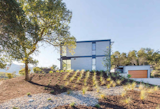The Jorgensen's Menlo Park home is a model of green design with features that are smart for everyone to consider. "Every project is different, but there are some universal things that will apply from project to project," says Feldman about designing a green home. "The first—and most obvious thing—is to always try to build less, to have a smaller house and be smart about how the rooms are designed and oriented so that you can get by with less space. Smart design will lead to a smaller building, but it won't feel smaller."
Rian and Melissa Jorgensen's 2 Bar House in Menlo Park boasts all the usual green design suspects: energy-efficient lighting, good insulation, renewable material finishes, radiant heat, and the roof is pre-wired for future PV panels. Executed by Feldman Architecture, the house requires only natural lighting during the day which keeps energy costs way down. Still, the most stunning aspect of the green design is the living roof planted with succulents, aloe, viviums, and ice plants. "I'm absolutely glad that we did it," says Melissa. "It turned out so well and I really enjoy sitting up there and taking advantage of it as much as I can. It's very peaceful." Read more about this total remodel here.
Project Name: Orinda Connect 8 & Connect 2
Website: connect-homes.com/dev...
It Will Get Loud: A Small Speaker That's Big on Sound
Home audio companies are managing to make speakers smaller, more portable, and more wallet-friendly while keeping sound quality as robust as their larger (and pricier) brethren. Soundfreaq's co-founder and creative director Matthew Paprocki will demo and deconstruct the award-winning Sound Stack and demo Sound Platform 2 to let you in on the technology behind making big sound come from a tiny package. See this Saturday, June 22, at 12:30 p.m. on the Demonstration Stage.
I.M. Pei, Luce Memorial Chapel (1963)
When architect I.M. Pei designed this chapel for Tunghai University in Taiwan, he had to take local conditions, like typhoons and earthquakes, into account. His plan, which, included a curved roof of glazed, diamond-shaped tiles and interior ribs of reinforced concrete that run like ribbons towards the cross mounted on the roof, was an elegant solution to the challenges of the local environment.
Photo courtesy Valter Wei, Creative Commons
The term “Internet of Things” was first documented by British visionary Kevin Ashton in 1999.
The first Internet appliance was a Coke machine at Carnegie Melon University in the early 1980s. The programmers could connect to the machine over the Internet, check the status of the machine and determine whether or not there would be a cold drink awaiting them, should they decide to make the trip down to the machine.
A toy that promotes analog learning and creativity in a digital world without technology? Meet the anaPad 2, $40-70—a magnetic white board housed inside a white acrylic frame with a wooden back and 3D geometric magnetic apps. Perfect for what kids do best—doodling, endlessly arranging things around, and game playing.
21k more photos





























![The courtyards offer a peaceful respite from the city. "[The home] provides an environment for its inhabitants that is experiential," says Teschendorrf.](https://images2.dwell.com/photos/6063391372700811264/6133565661315424256/original.jpg?auto=format&q=35&w=160)





